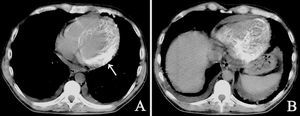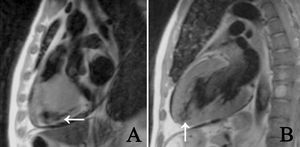Cardiac calcifications are a frequent finding in imaging studies. These calcifications can be classified into dystrophic (when they occur in previously nonviable myocardium) and metastatic (in previously healthy myocardium). The former are more frequent and their location in the myocardium is associated with prior infarction or surgery, congenital defects, and bacterial myocarditis. Metastatic calcifications are related to bone disease, hypercalcemia, hyperphosphatemia, an increase in CaP product, renal failure, dialysis, and hypervitaminosis. They can be the cause of arrhythmias, heart failure, and even death.
In a 40-year-old man with chronic renal failure secondary to glomerular nephritis, extensive myocardial calcifications were discovered on a computed tomography (CT) study performed for other reasons. Subsequently, cardiac magnetic resonance imaging (MRI) was carried out.
In the CT images (Figure 1), the calcifications (arrow) had a striated appearance and were located in the left ventricular wall and the interventricular septum. On MRI (T1-weighted fast spin-echo sequence in a 2-chamber view) (Figure 2), myocardial hypertrophy was documented, as well as signal loss (arrows) corresponding to calcifications. These features were more evident in the ventricular apex, left ventricular lateral wall, and interventricular septum, and were consistent with uremic cardiomyopathy with calcium deposits, together with hyperparathyroidism, secondary to the patient's renal failure.
Figure 1.
Figure 2.
Hyperuremia has been related to left ventricular hypertrophy, interstitial fibrosis, microcirculation changes, decreased myocardial tolerance to ischemia, and a greater prevalence of arteriosclerosis.
Cardiac calcifications are common in patients with hyperparathyroidism, although they usually remain undetected except in postmortem pathologic anatomy studies.



